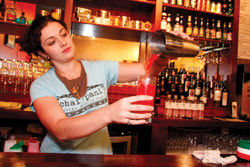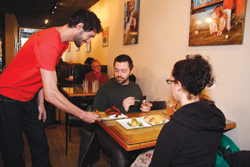If you've somehow managed not to get to Chai Pani yet, here's what you need to know about the supremely energetic Indian street-food eatery: The place was so popular its first week that its owners were forced to close their doors, turn customers away and spend a few days figuring out how they were going to handle the crowds, which exceeded their expectations by a whopping 300 percent.

"We were looking for a soft opening," sighs Molly Irani, who opened Chai Pani with her husband Meherwan. "We had to double our staff instantly."
There's been plenty for the restaurant's enlarged cast of busy cooks and cashiers to do: Eager customers have kept on coming, an impressive number of them on a daily basis. What makes Chai Pani work is the Iranis' precise understanding of not just what Asheville diners like to eat, but how and why they like to eat it.
To blatantly stereotype Asheville eaters (which is, of course, something that your average open-minded Asheville denizen would never, ever do), they like having lots of choices, which is why they're crazy about the whole build-your-own burrito thing. They're rather uncomfortable bossing anyone around, which means counter service is always good. They like vegetables better than meat, and like locally grown, organic vegetables best of all. Finally, they don't like to spend too much on food.
The Iranis made sure Chai Pani hit on all counts, smartly styling it after popular local spots that epitomize dining out in Asheville: "The goal was to create fantastic food, but we felt what people needed was the best possible food at the lowest possible price," Molly Irani says. "As a mother, I really appreciate places like Mamacita's and 12 Bones, where it's fun and casual."
Irani's maternal instincts apparently extended to Chai Pani's vast and remarkably affordable menu (of more than 40 items listed, only five exceed the $6.50 mark).
On another front, when the restaurant first opened, most of the dishes were purged of anything approaching standard levels of spice, because Irani worried that diners, unaccustomed to Indian ways of eating, would be put off by anything too peppery. For once, the Iranis had their customer base pegged wrong. While eaters of all ages and culinary backgrounds patronize Chai Pani, Meherwan Irani reports a surprising number of them are familiar with Indian street food and like it hot. With its proper spice restored, Chai Pani's soul-satisfying food seems to have found its stride. Everything I sampled when I last visited the restaurant was fresh and interesting and beautiful to look at. But the adjective that best describes Chai Pani's food is "balanced."
I'm thinking here of the samosa cholle, featuring a flaky samosa set upon a bowl of garbanzo stew. Like fried green tomatoes and spinach dip, samosas are a perfectly good food that's been doomed to near-irrelevancy in this country by shortcutting chefs. Frozen samosas — often indistinguishable from frozen pasties, frozen empanadas and every other frozen ethnic stuffed pie — are typically leaden and greasy. Not so the delicate samosas at Chai Pani.
Chai Pani's samosas are stuffed with pillowy mounds of potato, creating a lovely sensation of softness. But the supple samosa is counterbalanced by the more-engagingly textured stew, which is dabbed with green and red chutneys for an appealing avalanche of color.
"Food is supposed to be very textured, which people forget when they eat creamy North Indian food," Meherwan Irani says.
And it's not just the textures see-sawing their way to a pleasing equilibrium: The stew's spices play out against the sweetness of the homemade yogurt. The heat of the beans greets the chill of the chutney. Every plate at Chai Pani swings like a pendulum.
"We didn't set out to create an Ayuvedic restaurant, but a lot of Indian food is grounded in Ayurvedic principles," explains Molly Irani, referring to the traditional medicine system that stresses alignment.

Indeed, the only dish I wouldn't race to try again at Chai Pani was a spinach salad that lacked the components for the complexity so integral to everything else on the menu. While the greens, lightly pickled beets and tomatoes were all impeccably fresh, the "less is more" injunction just doesn't hold when the kitchen has such steady control over all its ingredients.
In the salad column, I greatly preferred a corn bhel, with its sprightly niblets of sweet corn bumping and grinding against an acidic lime-cumin dressing. The dish is traditionally made with puffed rice, but Irani's version is a terrifically rich translation. The salad is sprinkled with bits of puri, the flour crisps that make cameos all over Chai Pani's menu, so there's a bit of a crunch contrasting with the warm chunks of potatoes in the garden-harvest mix of onions, tomatoes and cucumbers.
Remember those potatoes from the samosas? While Chai Pani's menu is long, its ingredient list is short: "It's part of how we're able to make food affordable," Meherwan Irani says. "We cross-utilize ingredients, and sometimes people don't even realize it's the same thing."
Potatoes reappear on a traditional sandwich that's so startlingly Midwestern, I began to wonder whether there are many Lutherans in Bombay. According to the menu, Pav Bhaji is a "spicy potato and mixed vegetable hash, served on a warm bun." OK. But here's how I'd describe the dish to my fellow Michiganders: Crock-Pot-stew vegetables squished on a sweet King's Hawaiian roll. It's delicious, as is a companion farmer's cheese sandwich Meherwan Irani rightly calls "an Indian slider."
The most popular sandwich on the menu is a Kathi Kabab, perhaps because folks latch onto the familiar word "kabab" (which, in this case, doesn't denote any skewers) or perhaps because it's so rewardingly good. The kabab is a wrap of salty chicken, touched with ginger and studded with brittle split lentils. Best of all, the inside of the sandwich is slippery with egg. Indian vendors, Meherwan Irani says, often slather the egg wash on the outside of the kabab, but he didn't want to make things too messy.
Sticking to foods that could conceivably be eaten while standing up was important to Meherwan Irani, but Molly Irani persuaded him to add an elaborate thali presentation to the menu. Meherwan Irani was initially resistant, arguing the classic family dinner had no place at a street-centric eatery. But Molly Irani insisted customers wanted comfort food.
"The thalis are so popular, I'm glad we did them," Meherwan Irani concedes.
There's a vegetarian and nonvegetarian thali special each day, although so many eaters have expressed interest in trying both that Molly Irani is contemplating creating a combo she's currently calling "The Hungry Man Thali." While the showcased ingredient changes — I tried a sweet curried tilapia and a cumin-heavy cauliflower — the thali plate always includes rice, yogurt, chutney, bread and an addictive hot pickle that's one of the few things not made in-house. Meherwan Irani's mother, who helped train the cooks, devoted 48 hours to making a batch of pickles that was gone within days of the restaurant's opening. The Iranis now import their pickles from India (although they do make their own hot sauce, a sweet paste of local peppers with a faint after-burn. I especially liked it on the pakoras, a tangle of cleanly fried squash, cauliflower and onions).
With so many components, the thalis are a tough to-go order. The Iranis just this month solved the packaging conundrum by introducing Indian stainless-steel lunchbox containers and offering discounts to customers who bring in their "tiffin" for a thali refill.
The Iranis say Chai Pani isn't perfected yet; once they get it exactly right, Meherwan Irani says, "The long-term plan is to duplicate this in other towns. But we feel really lucky to start in Asheville." Asheville eaters, gifted a restaurant so neatly tailored to them, presumably feel pretty lucky too.
Xpress food writer Hanna Rachel Raskin can be reached at food@mountainx.com.



I’ve fallen in love with Chai Pani.
I ate there the first weekend they were open and thought it was okay. But since then, every time I have gone back the food has improved each and every time. It’s the most delicious place to grab a quick and cheap lunch in downtown.
Kudos to them, I’m glad that Mountain X gave them such a nice write up.
“With so many components, the thalis are a tough to-go order. The Iranis just this month solved the packaging conundrum by introducing Indian stainless-steel lunchbox containers and offering discounts to customers who bring in their “tiffin” for a thali refill.”
EXCELLENT.
I just learned about Chai Pani and wondered if they’d considered selling and using tiffin boxes for “to-go” orders.
The “tiffin take-out” system is very popular with Indian restaurants in Vancouver, BC. The diner buys a tiffin for about $12-15 and it includes the day’s lunch special. On subsequent trips they bring in their clean (!) tiffin and it’s filled with the day’s lunch special for a modest price, maybe $5-6. The consumer benefits from being able to enjoy their lunch authentically served in the world’s coolest (and recyclable) lunch box and no one has to buy or deal with styro containers that end up in landfills.